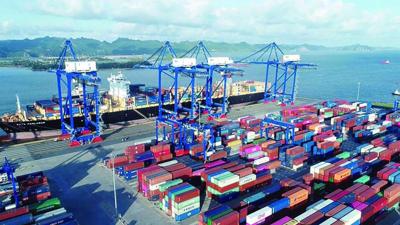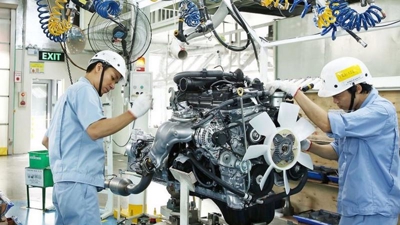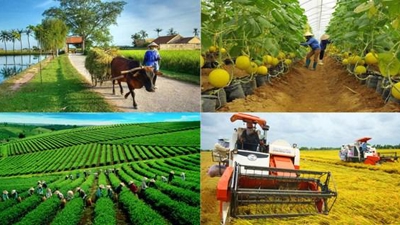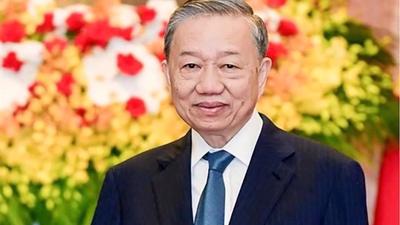PM urges resolve to achieve economic size of over $500 billion
Presenting a Government report to the National Assembly’s 9th session on May 5, PM Chinh reiterated the 2025 target of 8% GDP growth, an economic size exceeding $500 billion, and per capita GDP above $5,000.

Prime Minister Pham Minh Chinh presented a supplementary assessment report on the socio-economic development and state budget in 2024, along with updates on the performance of the socio-economic development and state budget tasks in early 2025 at the 15th National Assembly’s 9th session that opened in Hanoi on May 5, according to a report from the Vietnam News Agency.
In his report, PM Chinh announced that Vietnam had met or surpassed all 15 key targets in 2024, with 12 exceeding initial projections. A standout achievement was the rebound in labor productivity growth, which had lagged for three years but finally outstripped its goal.
The economy grew by 7.09%, among the highest rates in the region and the world, propelling Vietnam’s economic size to $476.3 billion and its global ranking to 32nd, up three places. Per capita GDP reached $4,700, inching closer to the upper-middle-income threshold.
The PM highlighted the momentum in early 2025, with first-quarter GDP growth estimated at 6.93%, the strongest start to a year in the 2020-2025 period. Macroeconomic conditions remained stable with inflation well-controlled and major economic balances secured. State budget revenue in the first four months topped VND944 trillion (nearly $36.4 billion), making up 48% of the annual target and marking a 26.3% year-on-year increase. Foreign trade value exceeded $275 billion, up 15%.
He also lauded drastic and coordinated progress in the country’s three strategic breakthroughs, while social security, public safety, and inclusiveness have been guaranteed in the spirit of leaving no one behind.
Infrastructure development has accelerated toward greater modernity, prioritizing key projects such as expressways, high-speed rail, airports, seaports, and infrastructure in education, healthcare, and sports. Vietnam aims to have over 3,000 km of expressways and 1,000 km of coastal highways later this year, partly via fast-tracking key sections of the North–South expressway for 2021-2025 and East–West expressways.
Looking ahead, he reiterated the 2025 target of 8% GDP growth, an economic size exceeding $500 billion USD, and per capita GDP above $5,000. To achieve this, he urged decisive action, including flexible and proactive monetary and fiscal policies, a potential budget deficit adjustment to 4-4.5% of GDP, and full disbursement of public investment capital for strategic projects. Emphasis is being placed on expediting site clearance, compensation procedures, and ensuring a stable supply of construction materials for national key infrastructure projects. Vietnam will also navigate US tariff policies while advancing trade frameworks to protect its interests without violating international commitments.
Domestically, the Government will aggressively realize and institutionalize the Politburo's recent resolutions on breakthroughs in sci-tech, innovation and national digital transformation; global integration, overhaul of law building and enforcement, and development of the private sector. In 2025, Vietnam aims to review and legalese pilot models and special policies through laws, while expanding decentralization and delegation of power. Targets for administrative reform include scrapping at least 30% of unnecessary business conditions, cutting 30% of processing time for administrative procedures, and reducing 30% of related costs.
The PM called for deep reform of public governance and public consultation on the revision of the Constitution 2013. A key economic pivot will be the restructuring of the national growth model; placing sci-tech, innovation, and digital transformation at the heart of Vietnam’s development engine. State-owned enterprises are also being urged to improve efficiency and pool resources for large-scale, high-impact projects.
Ministries, agencies, and localities must develop a quality workforce aligned with future market demands, especially in strategic areas such as artificial intelligence, data science, semiconductor, high-speed rail construction and operation, and nuclear energy.
One of the most significant social policy shifts announced was the allocation of resources to provide free tuition for preschool and general education students, effective from the 2025–2026 academic year.
In healthcare, he underlined the continued investment in preventive and grassroots healthcare systems. Vietnam is pushing a shift from reactive medical treatment to comprehensive health management, with the long-term goal of offering universal free hospital care to all citizens.
Sci-tech, innovation, and digital transformation remain core pillars across every sector, with the Government pledging expanded support to accelerate breakthroughs and competitiveness in the fourth industrial revolution. Another focus was on cultural development and improving the material and spiritual well-being of its people.
“With a far-sighted vision, bold thinking, and determined action, we must transform challenges into opportunities and driving forces, successfully completing the goals of the 2021–2025 period and emulating to obtain greater achievements to welcome Party congresses at all levels in the lead-up to the 14th National Party Congress”, the PM concluded.







